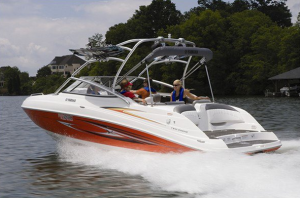Be Ready for a Successful Boating Season
 Are you getting ready to go boating? Make sure your boat is in tip-top shape. Here are some great suggestions from ACE Recreational Marine Insurance® that will help you ensure that your vessel will be ready for a successful launch, and safe and enjoyable cruising.
Are you getting ready to go boating? Make sure your boat is in tip-top shape. Here are some great suggestions from ACE Recreational Marine Insurance® that will help you ensure that your vessel will be ready for a successful launch, and safe and enjoyable cruising.
When Spring approaches, it’s an exciting time as you prepare for boating season. If your boat has been in lay-up throughout the winter months, here are some suggestions from ACE Recreational Marine Insurance® that will help you ensure that your vessel will be ready for a successful launch, and safe and enjoyable cruising.
Before the Launch
Inspect the Bottom – Rule number one: While working on the hull, always let the yard employees move stands and blocking. Do a thorough inspection of all the through-hull fittings above and below the waterline, and be sure all through-hulls are clear.
Zincs – Sacrificial zinc anodes attached to the hull and underwater metal parts should be removed prior to painting. Then clean the metal surfaces to which they attach until shiny, afterwards replace the zincs.
Transducers and Running Gear – Underwater transducers for depth sounders, fish finders and knot meters should be inspected. Make careful inspection of propellers and shafts, checking for damage and straightness. Inspect swim step supports, trim tabs, thruster grates and boarding ladders.
Rudders and Steering – Check the rudders and inspect the struts that support the prop shafts. Also be sure to check shaft bearings for wear.
Outdrive Hints – Those flexible rubber bellows between the drive and the transom don’t last forever. Inspect them carefully! Failed bellows are a major cause of sinking of outdrive-powered boats. Inspect the lower unit for oil leaks and change the oil.
Don’t forget the plug! – If the exhaust ports in the hull were plugged to keep critters out, remember to remove the plugs. And finally, if the hull has a drain plug, be sure it’s in place and tightened securely before launch.
Inside the Boat
Inner Hull Fittings and Steering – Make sure all seacocks operate smoothly, and inspect strainers. Pull the knot meter paddle, if it’s removable, and give it a spin while watching the gauge to be sure it is working. Operate the steering gear and inspect all hydraulic and/or mechanical components.
Clamps and Hoses – Inspect the hoses attached to all pumps, seacocks, and through-hulls. Replace any soft, bulging, cracked or damaged hoses. Make sure hose clamps are in good shape and free of rust.
Bilge Pumps and High Water Alarms – While you’re inspecting the bilges, lift the float switches and make sure your bilge pumps and high water alarm operate properly.
Engine and Batteries – Check and replace zincs and impellers in engine and generator cooling systems. Check all the V-belts, too. Mufflers and exhaust lines should be inspected for signs of leaks or deterioration, including hose clamps. Clean battery terminals and be sure the batteries are fully charged.
During the Launch
Launch Her Properly – As the weather warms up boatyards become very busy, often launching several boats an hour. When they’re so busy, yard employees may not take the time to properly check for leaks after the boat goes in the water. You, or someone else who knows the boat, should be there when she is launched.
Engine and Bilge – As soon as the boat is in the water, get below and check for leaks. Be sure the engine seawater intake seacock is open. With the engine running, check for exhaust water flow. Watch the temperature gauge to make sure the engine’s cooling system is working.
For Sailboats – If your sailboat’s mast was removed for winter storage, the yard will usually step it when the boat is in the water. Be sure all turnbuckles are secured with cotter pins once the rig has been tuned.
Before the First Voyage
Be in Ship Shape – Now that the boat is on her mooring or in her slip, spend some time checking everything before you depart on your first cruise. Start on the foredeck and work your way aft before going below.
Anchors and Mooring Lines – Be sure the anchor and rode are secured properly and ready to use. If there’s a windlass, make sure it works properly. Look over mooring lines and fenders, and the mooring bridle if the boat is kept on a mooring.
Deck Safety – Be sure pulpits, wire lifelines, stanchions and ladders are secure and in good repair. Make sure the running and anchor lights work.
Rig Deck Canvas and Check for Leaks – Set up deck canvas. Secure windows, portlights and hatches and give the boat a thorough washing. As soon as you’re done, go below and look for leaks.
Check Your Shore Power – Before you plug into shore power, inspect the ends of the cord and the receptacle that’s mounted on the boat for any signs of heat damage.
Electrical and Mechanical – Start engines and generators and warm them up thoroughly. Check battery voltage; a 12-volt system charges at about 14 volts. Inspect fuel, cooling and exhaust systems for leaks.
Water Tanks and Water Heater – If the domestic water and waste systems were winterized, they will need draining and flushing, and any fittings that were disconnected need to be secured.
Check the LPG/CNG Gas System – If you have a propane system, light a burner on the stove. Then close all valves and check for leaks.
Change Engine Oil – It’s a good idea to change the oil and filters before the season. This should be done even if oil was changed last Fall.

